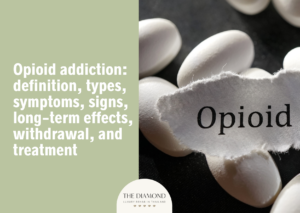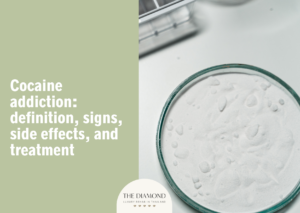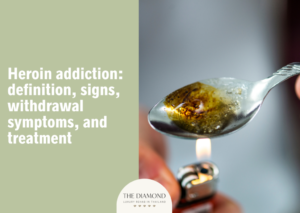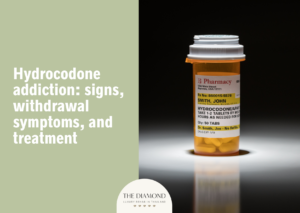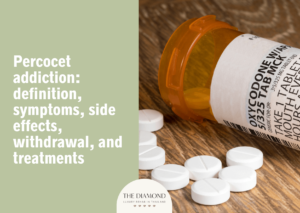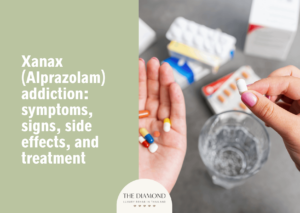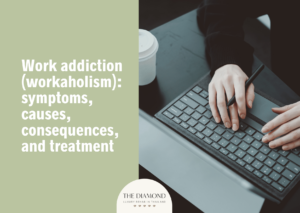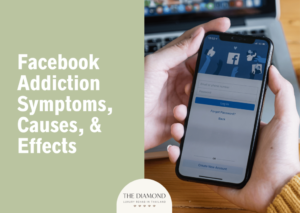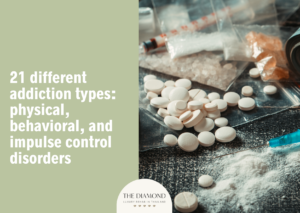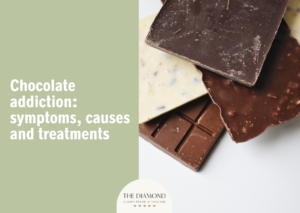Cocaine addiction: definition, signs, side effects, and treatment
Table of content
- What is cocaine addiction?
- Is cocaine addictive?
- What are the signs of cocaine addiction?
- What are the causes of cocaine addiction?
- What are the side effects of cocaine addiction?
- What are the treatment methods for cocaine addiction?
- Can you quit cocaine on your own?
- How to tell if a person is using cocaine?
- How can you help a person with cocaine addiction?
- How long does cocaine addiction recovery last?
- How is cocaine overdose treated?
- When is cocaine addiction counseling necessary?
- What are the symptoms of cocaine addiction withdrawal?
- What are the differences between cocaine abuse and cocaine addiction?
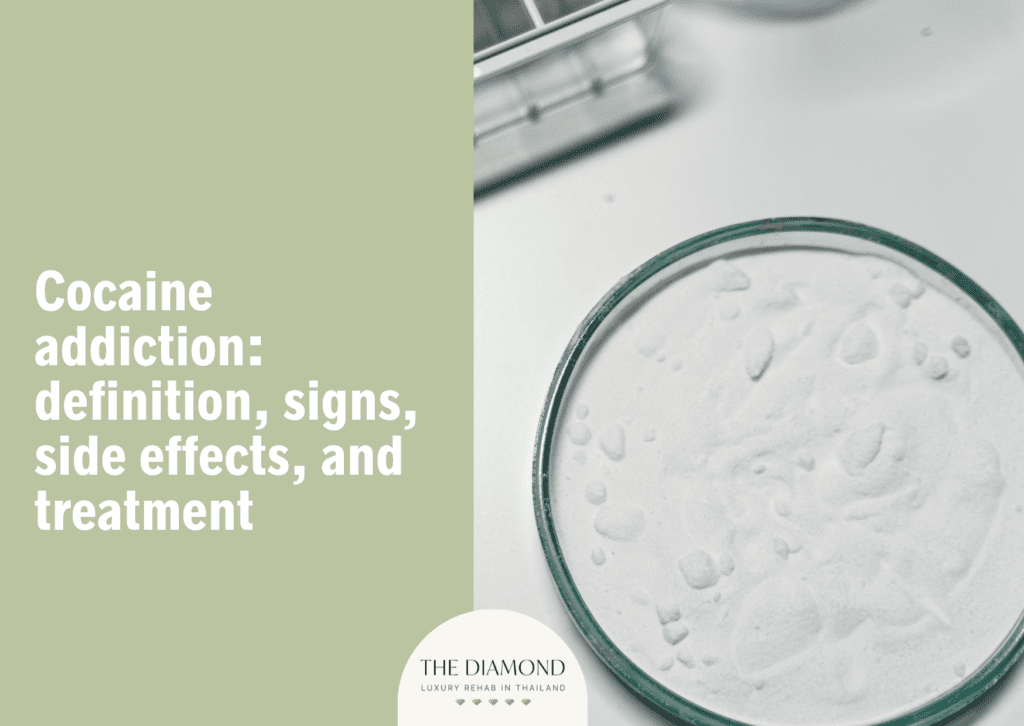
Cocaine addiction is a long-term illness marked by compulsive use of the drug in spite of negative effects on one’s social, mental, and physical health. Changes to the reward system in the brain cause strong cravings and a lack of control over drug use.
The signs of cocaine addiction include constantly thinking about cocaine and plotting ways to get more, heightened anxiety or restlessness when supply runs low, increasing dosage or frequency beyond intended limits, disinterest in activities unrelated to cocaine, rapid weight loss, dilated pupils, irritability and mood swings, neglect of personal responsibilities, secrecy and social withdrawal and deteriorating personal relationships.
The side effects of cocaine addiction are categorized into short- and long-term consequences, with short-term side effects including increased heart rate and blood pressure, dilated pupils and sensitivity to light, euphoria, runny nose, decreased appetite, as well as paranoia and anxiety. Long-term side effects of cocaine addiction include cardiovascular problems, multiorgan damage, HIV/AIDS, hepatitis C and sexual dysfunction.
Treatment options for cocaine addiction include contingency management (CM), cognitive behavioral therapy (CBT), couples therapy and intensive outpatient therapy (IOT).
What is cocaine addiction?
Cocaine addiction is a chronic, relapsing disorder marked by the compulsive use of cocaine, a powerful stimulant drug, despite significant adverse consequences. When an individual uses cocaine over and over again, changes happen in the brain’s reward system, especially the dopamine pathways responsible for drive and pleasure.
Even when aware of the effects of cocaine usage on physical and mental health and social interactions, a cocaine addict often struggles with intense cravings and an inability to manage use.
The brain grows dependent on the substance to trigger euphoria, resulting in tolerance and withdrawal symptoms during abstinence. Continuous use to prevent uncomfortable symptoms gives way to cocaine dependence, especially in users of crack cocaine, gradually reducing the ability to manage drug-seeking behavior.
How common is cocaine addiction?
Cocaine addiction is widespread in the United States (US), with about 1.5 million individuals meeting the Diagnostic and Statistical Manual for Mental Disorders, Fifth Edition (DSM-5) criteria for cocaine use disorder (CUD), according to a study by Schwartz et al., titled “Cocaine Use Disorder (CUD): Current Clinical Perspectives” published in September 2022.
In total, approximately 2.2 million Americans use cocaine regularly, making it more common than methamphetamine use (600,000 users). The lifetime prevalence of CUD is estimated at roughly 20% among individuals who have ever used cocaine. In other words, one in five users eventually develops the disorder at a certain point in their lifetime.
Cocaine consumption and associated issues, including CUD, have been rising among adults and adolescents. National data from 2015 to 2017 indicated overdose fatalities linked to cocaine use doubled between 2015 and 2016.
Is cocaine addictive?

Yes, cocaine is highly addictive. As a powerful stimulant, the drug rapidly affects the brain’s reward system, producing an intense but short-lived sense of euphoria and energy. The substance raises dopamine levels, producing sensations of pleasure and driving repeated use.
Many users binge on coke to extend the high, quickly leading to psychological dependence. The brain then adapts to the drug’s impact, requiring larger amounts to achieve the same sensation. The pattern fuels compulsive use and makes stopping extremely difficult.
Why is using cocaine addictive?
Using cocaine is addictive because the drug powerfully interferes with the brain’s communication system, especially in areas linked to motivation and satisfaction. When a person engages in cocaine use, the substance triggers an intense surge of dopamine, overwhelming the brain’s natural balance.
The chemical flood produces a rush of alertness and pleasure, prompting the brain to crave for cocaine repeatedly. With frequent exposure, self-control weakens, and daily functioning starts to revolve around seeking the next high.
Cravings become stronger as the brain expects the stimulant to function normally. As a result, people often chase the initial euphoria, unaware of how addictive cocaine has become, reshaping thinking and behavior.
Is cocaine addictive from the first try?
No, cocaine is not typically addictive from the first try, but even initial use sets the stage for addiction. A 2022 study by Schwartz et al., called “Cocaine Use Disorder (CUD): Current Clinical Perspectives” supported this through findings showing among people who have experimented with cocaine, even a single time, about 15% develop CUD within a decade.
The percentage surpasses the rates for cannabis at 8% and alcohol at 12–13%. The shift from initial exposure to CUD happens swiftly, with roughly one in 16 to 20 users becoming dependent during the first year. The average age of first cocaine use is around 20, leaving many young adults burdened with addiction early in life.
What are the signs of cocaine addiction?
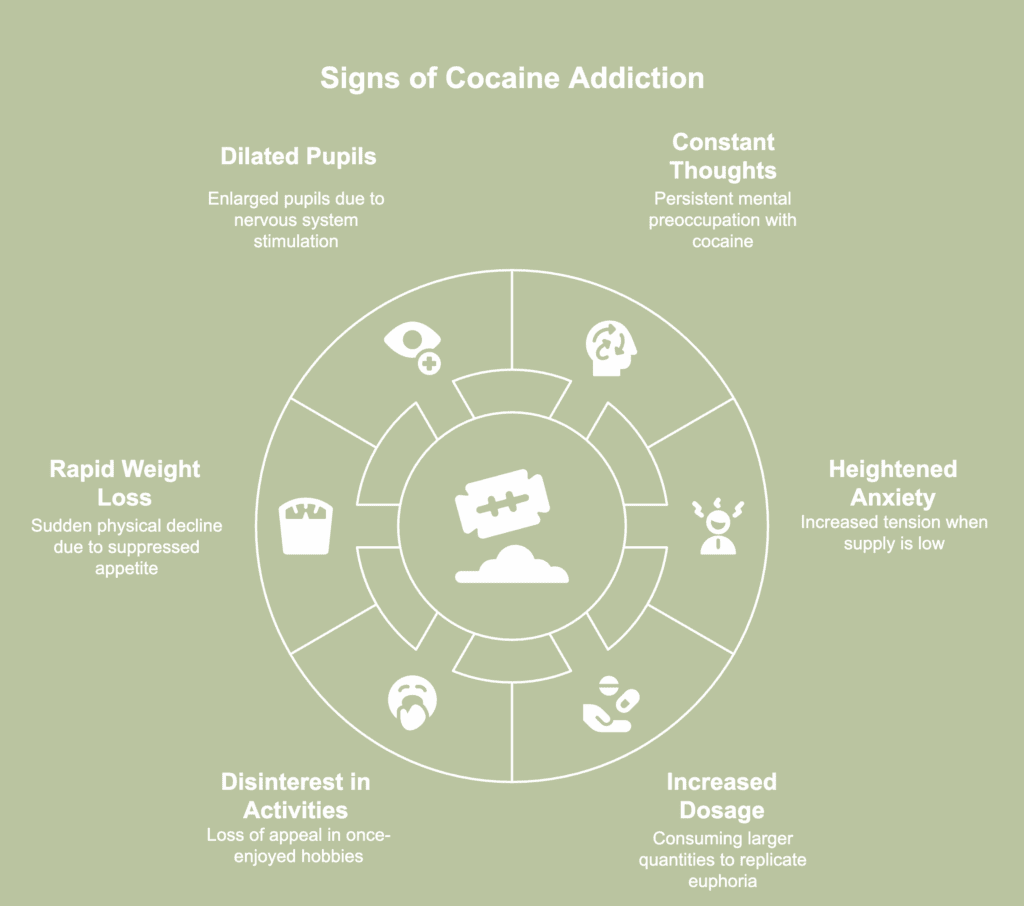
Signs of cocaine addiction refer to the obvious behavioral, psychological and bodily clues pointing to a person’s dependence on the drug. The signs of cocaine addiction are listed below.
- Constantly thinking about cocaine and plotting ways to get more: Persistent mental preoccupation with cocaine reflects deep psychological dependence. Daily thoughts begin revolving around when, where and how to use the drug again, distracting from work or social obligations. Planning access becomes habitual, with much of the day spent anticipating the next dose. Such fixation signals how the substance has taken priority over meaningful pursuits and healthy routines.
- Heightened anxiety or restlessness when supply runs low: A noticeable rise in tension appears when access to cocaine becomes uncertain. The individual displays agitation or impatience while searching for the next fix. Emotional distress increases as cravings intensify, making calmness nearly impossible until more of the drug is secured.
- Increasing dosage or frequency beyond intended limits: Cocaine users begin consuming larger quantities after the desired rush weakens. Attempts to replicate the original euphoria usually lead to escalating doses or shorter breaks between use. Control diminishes as cravings dominate, prompting risky decisions and disregard for personal well-being.
- Disinterest in activities unrelated to cocaine: Activities once enjoyed, like exercise, music or spending time with friends, lose appeal. The stimulant’s grip gradually replaces satisfaction gained from natural rewards, narrowing focus exclusively to drug use. As motivation fades, the person tends to withdraw from meaningful connections or creative outlets. Disengagement from hobbies marks a clear shift from balanced living to drug-centered existence.
- Rapid weight loss: Cocaine suppresses appetite and speeds up metabolism, leading to sudden physical decline. Meals are skipped as energy and hunger cues become distorted. Visible thinness, fatigue and nutrient deficiencies soon follow, reflecting the body’s deteriorating state. The physical transformation apparent in a cocaine addict frequently alerts others to an escalating problem.
- Dilated pupils: One of the signs of cocaine abuse is the pupil becoming enlarged, owing to the drug’s stimulating effects on the nervous system. Dilated pupils are a common indication of recent use and tend to persist for several hours. The symptom additionally increases sensitivity to light and causes discomfort. A 2019 case report by Iyer et al., titled “Anisocoria from Cocaine Exposure: A Case Report” described a patient presenting with anisocoria, or unequal pupil size, resulting from topical cocaine exposure. She confessed to snorting cocaine the day prior to arriving at the emergency department and had rubbed her left eye afterward, triggering the condition.
- Irritability and mood swings: Emotional stability weakens under the influence of cocaine’s powerful highs and subsequent crashes. Individuals swing between confidence and agitation within short periods. Minor frustrations provoke anger, while depressive states emerge as the drug’s effects fade. Emotional fluctuations strain relationships and make social interactions challenging.
- Neglect of personal responsibilities: Responsibilities at work, home or school begin slipping as cocaine takes precedence. Missed deadlines, absenteeism and declining performance follow repeated use. Routine obligations start feeling burdensome compared with the allure of intoxication. Avoidance of duty reflects a decline in discipline caused by prolonged substance use.
- Secrecy and social withdrawal: People struggling with cocaine addiction frequently hide usage patterns from loved ones. Deceptive behavior increases, including lying about whereabouts or finances. Isolation becomes a coping strategy to prevent confrontation or judgment. According to a 2017 paper by Boris B. Quednow called “Social cognition and interaction in stimulant use disorders,” individuals using cocaine tend to exhibit stronger Machiavellian traits, marked by manipulative tendencies and pragmatic moral views. Dependent cocaine users often demonstrate reduced cooperativeness, limited concern for social acceptance and increased impulsivity, reflecting a general disregard for conventional standards.
- Deteriorating personal relationships: Communication with family and friends grows strained as addiction advances. Conflicts emerge due to broken promises, erratic conduct or emotional unpredictability. Loved ones feel helpless or betrayed as a result, amplifying tension within the household. Continued conflict brings loneliness to everyone involved, reinforcing the destructive cycle of dependence.
What are the causes of cocaine addiction?
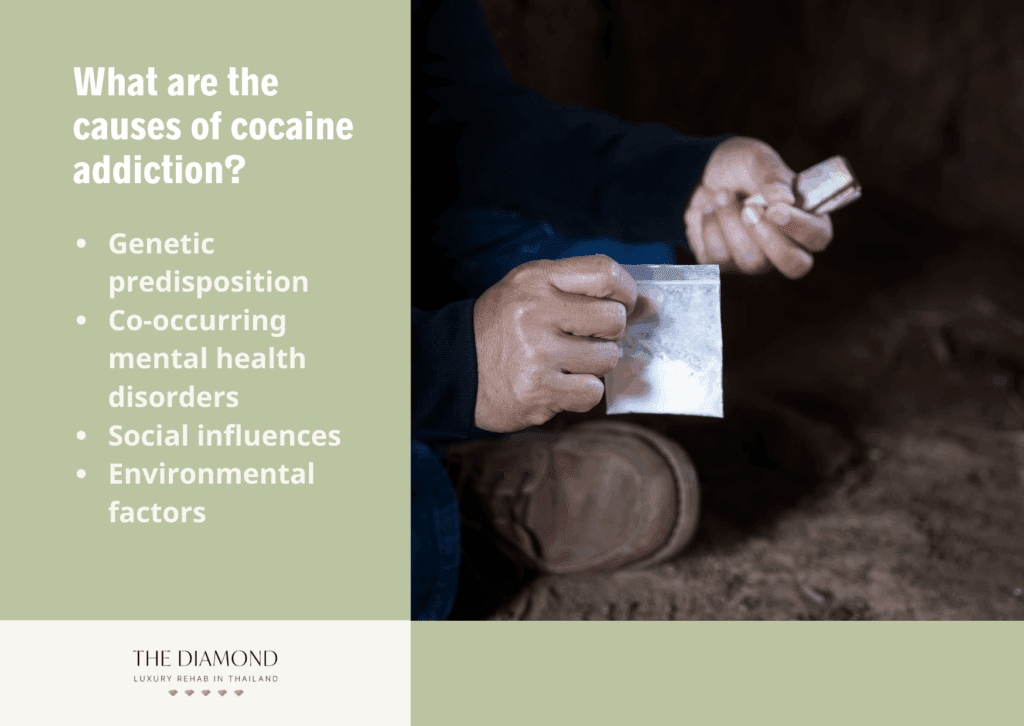
Causes of cocaine addiction relate to the elements fueling a compulsive reliance on cocaine. The causes of cocaine addiction are listed below.
- Genetic predisposition: Genetic factors play a significant role in the susceptibility to cocaine addiction. Certain gene variations influence how dopamine and serotonin systems react to stimulant exposure, making certain individuals more susceptible to compulsive use. Family history of substance misuse frequently heightens biological sensitivity, intensifying the reinforcing effects of cocaine. As per a 2021 review by Fernàndez-Castillo et al., titled “Molecular genetics of cocaine use disorders in humans,” family studies reveal relatives of individuals diagnosed with CUD face a 4.4-fold higher likelihood of developing substance use disorders (SUDs).
- Co-occurring mental health disorders: Certain mental health disorders increase the likelihood of cocaine misuse. Individuals experiencing psychological distress are likely to turn to stimulants as a misguided coping mechanism for fatigue, emptiness or lack of motivation. Evidence indicates periods of cocaine use intensify bipolar disorder symptoms and accelerate the progression of the illness, as noted in a 2020 publication from the National Institutes on Drug Abuse (US) titled “Common Comorbidities with Substance Use Disorders Research Report.”
- Social influences: Peer acceptance, cultural attitudes and social environments strongly shape patterns of drug consumption. Exposure to groups normalizing stimulant use blurs perceptions of risk and encourages experimentation. Subtle social pressure or curiosity about shared experiences rapidly shift casual use toward dependency. Belonging or admiration frequently outweighs caution, especially among impressionable individuals.
- Environmental factors: Unstable living conditions, exposure to trauma and lack of supportive relationships heighten susceptibility to cocaine addiction. Economic hardship and neighborhood drug availability further compound the risk, creating easy access and fewer barriers to use. Stressful surroundings encourage escape through substances rather than constructive coping strategies. Such conditions expose someone to a cycle of chaos, reinforcing continued dependence and diminishing hope for stability.
What are the side effects of cocaine addiction?
Side effects of cocaine addiction are classified into short- and long-term. The side effects of cocaine addiction are listed below.
Short-term side effects
- Increased heart rate and blood pressure: Cocaine stimulates the central nervous system, forcing the heart to pump faster and the arteries to constrict. The rapid cardiovascular response raises blood pressure to dangerous levels, placing strain on the heart and circulatory system. Among emergency department patients presenting with non-traumatic chest pain, between 14–25% in urban hospitals and 7% in suburban facilities test positive for cocaine or its metabolites, according to a 2024 study by van Amsterdam et al., called “Cardiovascular Risks of Simultaneous Use of Alcohol and Cocaine—A Systematic Review.” This finding is alarming, as approximately 4–6% of individuals experiencing cocaine-related chest pain in emergency care develop acute myocardial infarction (AMI). During the initial hours following cocaine consumption, the likelihood of AMI is estimated to be 4.3 to 24 times greater compared with those who have not used the drug.
- Dilated pupils and sensitivity to light: Cocaine use activates the sympathetic nervous system, causing the pupils to widen noticeably. Enlarged pupils allow more light into the eyes, intensifying brightness and discomfort in well-lit areas. Numerous users report difficulty adjusting to daylight or indoor lighting after taking the drug. Visual disturbances reveal recent stimulant exposure even before other symptoms appear.
- Euphoria: Cocaine produces a strong euphoric high and greater energy. Increased dopamine levels in the brain cause tremendous pleasure in a user. The artificial pleasure overwhelms natural reward circuits, making regular activities feel dull by comparison. However, the effects are short-lived, often followed by a crash leaving the user fatigued and depressed. The fleeting contrast fuels repeated use as individuals look forward to the same powerful sensation each time.
- Runny nose: Frequent inhalation of cocaine irritates the nasal passages and damages delicate mucous membranes. Continuous exposure dries the tissue, leading to inflammation and excessive mucus discharge. A 2021 case report by Di Cosola et al., titled “Cocaine-Induced Midline Destructive Lesions (CIMDL): A Real Challenge in Diagnosis” revealed how three weeks into regular cocaine snorting, inflammation and ulceration develop in the nasal lining. Continued inhalation results in reduced blood flow to nasal tissues, causing bone and cartilage damage and eventually leading to midline perforation. Such injuries, first documented in 1988, are known as cocaine-induced midline destructive lesions (CIMDL).
- Decreased appetite: Cocaine suppresses hunger signals by overstimulating brain centers responsible for regulating energy and satisfaction. Meals lose appeal, and users skip eating for long periods without realizing the nutritional toll. Significant weight loss develops as caloric intake drops while metabolism speeds up. Malnutrition and weakness gradually set in, affecting immunity and stamina.
- Paranoia and anxiety: Large amounts of cocaine excessively activate brain areas controlling awareness and threat perception. Users frequently become jumpy, distrustful or convinced others intend harm. Rapid thoughts and racing heartbeat intensify unease, leading to erratic behavior. In severe cases, psychosis or hallucinations emerge, further distorting reality.
Long-term side effects
- Cardiovascular problems: Serious cardiovascular complications result from long-term abuse of cocaine. Acute disorders including arrhythmia and acute myocardial infarction (MI) as well as chronic disorders like cardiomyopathy and coronary artery disease (CAD) are among the cardiac problems linked to cocaine use, according to a 2019 study by Sung Tae Kim and Taehwan Park, titled “Acute and Chronic Effects of Cocaine on Cardiovascular Health.” Sudden death is a possible outcome of cocaine-induced cardiotoxicity.
- Multiorgan damage: Long-term cocaine consumption exerts immense strain on the body’s major organs, leading to progressive and sometimes irreversible harm. The heart experiences increased workload, the liver struggles to process accumulated toxins and the kidneys fail to filter waste efficiently. Lungs suffer from repeated exposure to harmful residues, especially among people who smoke or inhale the drug. Sustained use eventually disrupts multiple systems simultaneously, leaving the body in a constant state of physiological distress.
- HIV/AIDS: Habitual cocaine use contributes to the spread of human immunodeficiency virus (HIV)/acquired immunodeficiency syndrome (AIDS) through unsafe injection practices and heightened sexual risk-taking. The drug’s stimulating effects lower inhibitions, leading to poor decision-making and unprotected contact. As per a 2022 review by Sonti et al., titled “Crossroads of Drug Abuse and HIV Infection: Neurotoxicity and CNS Reservoir,” research examining substance use among individuals with HIV revealed crack cocaine significantly accelerates the progression of the infection to AIDS. Findings showed a faster decline in CD4+ cell count among cocaine users compared with non-users. CD4+ cells, a type of white blood cell, play a vital role in defending the body against infections by coordinating immune responses. Although cocaine was once mainly inhaled or snorted, injection use has become increasingly common.
- Hepatitis C: Transmission of hepatitis C commonly occurs among cocaine users who share syringes or other contaminated equipment. The virus targets the liver, causing chronic inflammation that gradually evolves into scarring and impaired function. Various individuals remain asymptomatic for years, allowing extensive damage to occur unnoticed. Untreated infection raises the likelihood of cirrhosis and liver cancer, both difficult to manage without early intervention.
- Sexual dysfunction: Cocaine disrupts the balance of hormones and blood flow essential for healthy sexual performance. Prolonged stimulant use leads to diminished libido, erectile difficulties in men and reduced arousal in women. The psychological effects, such as anxiety and emotional detachment, intensify the physical challenges by negatively affecting intimacy between partners.
What are the treatment methods for cocaine addiction?
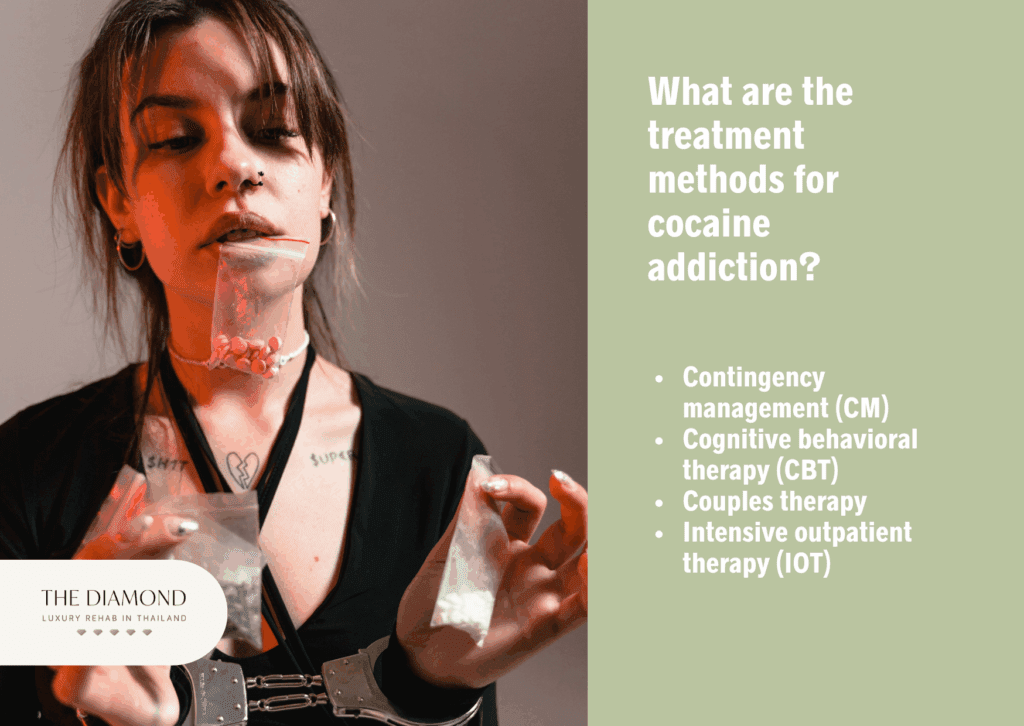
Treatment methods for cocaine addiction describe a wide range of practices aimed at addressing the condition. The treatment methods for cocaine addiction are listed below.
- Contingency management (CM): The foundation for CM rests on the idea that a rewarded behavior becomes more likely to be repeated. A 2019 review by Kyle M. Kampman, “The Treatment of Cocaine Use Disorder,” highlighted the use of CM in the form of voucher-based reinforcement therapy (VBRT) as an effective strategy for promoting early cocaine abstinence. In VBRT, patients earn vouchers for completing specific goals, such as passing drug tests. Redeemable for community products and services, the vouchers provide immediate and palpable incentives for upholding abstinence. Immediate rewards strengthen motivation and reinforce sobriety, making sustained abstinence more achievable.
- Cognitive behavioral therapy (CBT): CBT teaches individuals to recognize the thoughts and triggers driving cocaine use, replacing harmful habits with healthier coping responses. Sessions involve practical exercises designed to improve emotional regulation and problem-solving. The structured framework encourages reflection, helping individuals regain control of decision-making. Through consistent practice, people develop resilience against cravings and stressors likely to prompt drug use.
- Couples therapy: Couples therapy focuses on repairing strained relationships and fostering trust between partners affected by cocaine misuse. Both participants work together to understand how substance use disrupts communication, intimacy and shared responsibilities. The therapist guides constructive dialogue, encouraging empathy and cooperative problem-solving. Strengthening relationship dynamics enhances stability and creates a supportive home environment for sustained recovery.
- Intensive outpatient therapy (IOT): IOT provides structured treatment for persons requiring consistent support while maintaining daily responsibilities. Participants attend several therapy sessions each week, combining individual and group work under clinical supervision. IOT, providing at least nine hours weekly of group, individual and family sessions, proved as effective as inpatient programs while being more affordable in 1990s trials, as noted in a 2019 paper called “The Treatment of Cocaine Use Disorder” authored by Kyle M. Kampman. Large-scale studies involving 918 and 142 participants revealed both IOT and lower-intensity treatments (one to two sessions weekly, up to six hours) cut cocaine use by roughly 52% within six to seven months, alongside better mental health and employment outcomes.
Can you quit cocaine on your own?
No, you cannot quit cocaine on your own. Quitting cocaine alone and without professional help is rarely successful and tends to be risky. Cocaine disrupts the brain’s reward system, making self-control extremely difficult once dependence develops.
Without medical or psychological support, withdrawal symptoms such as exhaustion, severe mood swings and strong cravings lead to relapse. Quitting cocaine safely requires a structured approach addressing both the physical and psychological aspects of addiction.
Professional detox programs help manage withdrawal and reduce the dangers linked to sudden cessation. Behavioral therapies, including cognitive behavioral therapy and contingency management teach coping strategies and relapse prevention techniques.
Counseling sessions reinforce motivation and accountability throughout recovery. Learning how to stop cocaine use effectively involves guidance from addiction specialists who tailor treatment plans to individual needs.
How to tell if a person is using cocaine?
To tell if a person is using cocaine, look out for sudden and unusual changes in mood, energy or behavior. One of the most common signs of cocaine use includes bursts of confidence or talkativeness followed by irritability or exhaustion.
Physical indicators appear as a runny or bloody nose, frequent sniffing and dilated pupils sensitive to light. People using cocaine lose weight quickly due to suppressed appetite and disrupted sleep patterns.
Secrecy or disappearing for long periods further suggest increased substance involvement. Emotional instability, restlessness or intense focus on obtaining the drug are a few warning signals.
To identify whether cocaine use is occurring, combine behavioral cues with physical symptoms instead of relying on one factor alone. Paraphernalia such as small baggies, mirrors or rolled paper bills are typically found among users as well.
How can you help a person with cocaine addiction?
You can help a person with cocaine addiction by being there consistently and urging them to seek professional help. Approach the matter first with empathy, free from judgment, while creating a secure environment for candid discussion.
Express genuine concern for their health and emphasize the negative impact of drugs on both body and mind. Educate yourself about addiction to better understand withdrawal, relapse risks and behavioral patterns linked to cocaine use.
Focus on expressing concern for the individual’s well-being rather than past mistakes. When supporting somebody through addiction, patience and understanding are key, as recovery often requires time and effort. Dealing with a friend addicted to drugs requires a compassionate attitude.
Offer assistance in locating treatment programs, attending therapy sessions or connecting with support groups to ensure a sense of support. True help means guiding a person toward sustainable recovery through compassion and steady involvement. Remember; the objective is to support and help while letting experts deliver the required treatment for long-term recovery.
How long does cocaine addiction recovery last?
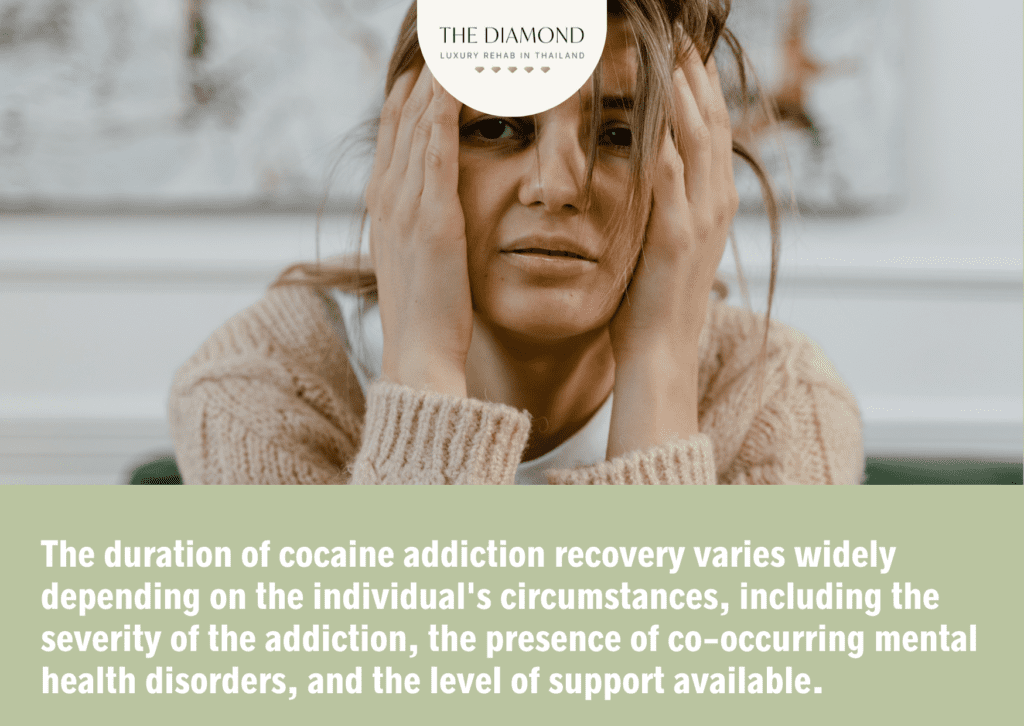
The duration of cocaine addiction recovery varies widely depending on the individual’s physical health, duration of use, commitment to treatment and the level of support available to them.
Recovery typically begins with detoxification, typically lasting from a few days to a week, followed by ongoing therapy and support. For individuals attending a rehab facility, treatment programs range from 30 to 90 days, but long-term recovery involves much more than completing a program.
Initial withdrawal, otherwise known as the “crash phase,” typically takes about one to two weeks, as the body adjusts to the absence of the drug. Psychological recovery, however, extends far longer and necessitates months of consistent therapy and support.
The brain’s reward system takes significant time to heal as well, making relapse prevention strategies essential throughout recovery. Numerous individuals remain engaged in recovery for months or years, as the process involves sustained effort toward achieving and preserving a substance-free lifestyle.
How is cocaine overdose treated?
Cocaine overdose is treated by first giving sedatives, typically benzodiazepines, to reduce agitation and heart rate, according to a continuing education activity by John R. Richards and Jacqueline K. Le, “Cocaine toxicity,” last updated in June 2023.
Medical professionals then examine for conditions like pregnancy or hypoglycemia while stabilizing respiration, circulation and body temperature. Treatments for chest discomfort and hypertension include labetalol, which helps safely regulate both conditions.
Other medications used to lower blood pressure include calcium channel blockers like verapamil or diltiazem. Avoiding physical restrictions helps to keep agitation from getting worse. Combining benzodiazepines with antipsychotics like olanzapine or haloperidol improve sedation in cases of extreme restlessness.
Fanning and tepid misting are two cooling techniques used to lower dangerously elevated body temperatures. Rare instances of cocaine overdose involving irregular heart rhythms are treated with intravenous lipid therapy or lidocaine.
When is cocaine addiction counseling necessary?
Cocaine addiction counseling becomes necessary once cocaine use begins to interfere with daily functioning, relationships or physical health. Early intervention through drug counseling helps individuals recognize harmful patterns before dependence fully develops.
Persons struggling with cocaine dependence find it difficult to quit alone, making structured therapy a vital part of recovery. During cocaine treatment, therapy sessions provide emotional support and teach strategies to manage cravings.
Counseling is additionally important after detox, as psychological symptoms persist even when withdrawal fades. Family sessions are sometimes included to rebuild trust and improve communication at home.
Ongoing cocaine addiction treatment ensures progress continues beyond initial recovery, reducing the likelihood of returning to drug use. Counseling plays a stabilizing role, offering guidance during vulnerable periods of adjustment.
What are the symptoms of cocaine addiction withdrawal?
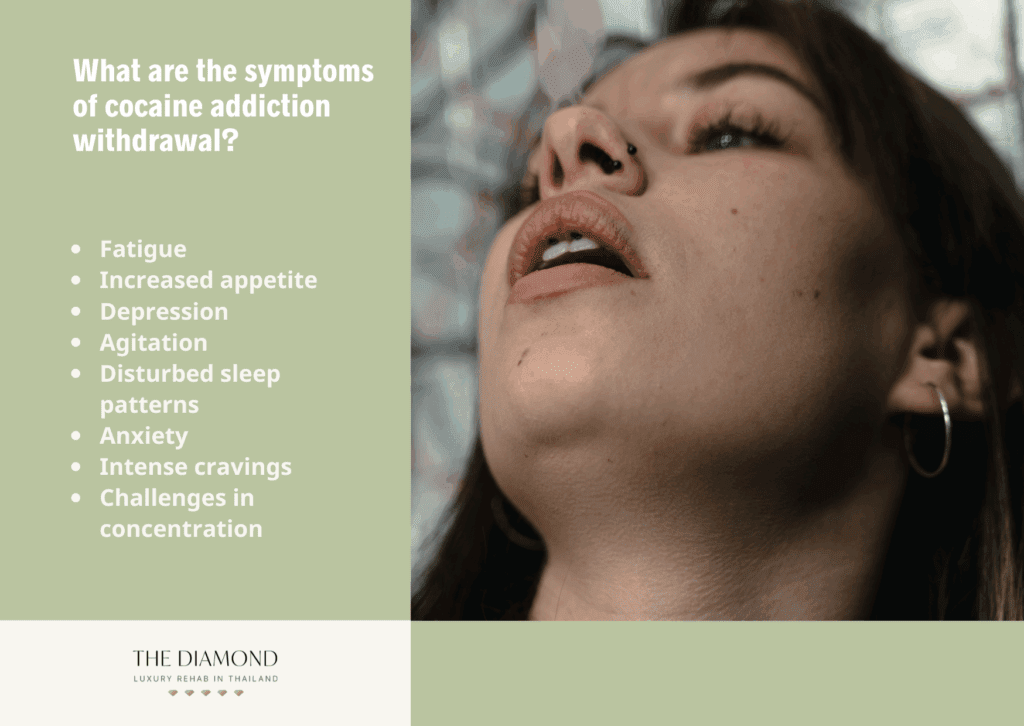
Symptoms of cocaine addiction withdrawal refer to the physical and psychological effects experienced by individuals when reducing or ceasing cocaine use after prolonged dependence. The symptoms of cocaine addiction withdrawal are listed below.
- Fatigue: Since energy reserves are exhausted after extended stimulation, extreme fatigue usually occurs after cocaine leaves the body. Lacking the invigorating effects of the drug, movement becomes a chore, and motivation crumbles as a result of exhaustion. Throughout the day, affected people feel a heavy, lethargic feeling. Physical fatigue decreases motivation and discourages physical activity during the initial stages of recovery.
- Increased appetite: After cocaine use stops, appetite usually rebounds sharply due to the drug’s prior suppression of hunger signals. People frequently have cravings for foods high in calories, particularly those heavy in sugar or carbohydrates. During the withdrawal phase, sudden hunger causes substantial weight gain. Restoring healthy dietary practices is crucial to balancing energy and mood.
- Depression: A deep, lingering sadness accompanies drug withdrawal as dopamine levels drop. Pleasure becomes difficult to experience, creating feelings of emptiness and hopelessness. As per a 2021 study by Cabé et al., called “Influence of Clinical Markers of Dopaminergic Behaviors on Depressive Symptoms During Withdrawal in Cocaine Users,” depressive symptoms occur more frequently among cocaine users than in the general population, with lifetime rates ranging from 25% to 61% across studies. Such symptoms appear most often in individuals entering treatment, likely due to greater symptom severity and more advanced substance use disorders.
- Agitation: During withdrawal, the absence of stimulation causes inner turmoil marked by restlessness and volatility. Even minor irritations evoke disproportionate anger, creating tension in daily interactions. The nervous system, no longer numbed or elevated, reacts erratically while relearning how to balance between calm and alertness.
- Disturbed sleep patterns: Withdrawal disrupts natural sleep cycles, causing difficulty falling asleep or staying asleep for long periods. Nightmares and vivid dreams are common as the brain rebalances neurotransmitters affected by cocaine. A September 2025 paper by Medigue et al., “Longitudinal disturbances of objective sleep architecture in cocaine use disorder: A translational systematic review,” revealed withdrawal affects sleep in different ways. During the early stage, people often experience longer and deeper REM sleep as the body tries to recover. In later stages, REM sleep decreases again, and overall sleep quality worsens.
- Anxiety: A sharp sense of unease replaces cocaine’s former euphoria, generating racing thoughts and physiological tension. The heart beats faster, breathing quickens and an invisible weight of dread follows even calm situations. Such anxiety stems from chemical imbalance and the brain’s uncertainty about functioning without stimulation.
- Intense cravings: A powerful urge to use cocaine dominates thought during withdrawal, driven by lingering brain adaptations. Cravings tend to arise suddenly, triggered by memories, stress or familiar environments. Resisting the impulse becomes a daily challenge for people in recovery.
- Challenges in concentration: Cognitive clarity declines as neurotransmitters disrupted by cocaine struggle to normalize. Tasks requiring focus or memory feel mentally draining or frustrating. Thoughts wander easily, short-term memory lapses become common and productivity plummets without the stimulant’s artificial clarity. Many describe an internal haze where thinking feels fragmented and sluggish.
What are the differences between cocaine abuse and cocaine addiction?
Differences between cocaine abuse and cocaine addiction pertain to the varying consequences and patterns of cocaine consumption. The differences between cocaine abuse and cocaine addiction are presented in the table below.
| Differences Between Cocaine Abuse and Cocaine Addiction | ||
| Aspect | Cocaine Abuse | Cocaine Addiction |
| Definition | Repeated or excessive cocaine use leading to harmful effects but without complete loss of control. | A chronic condition marked by compulsive drug seeking and use despite severe negative consequences. |
| Control over use | The person still has some ability to limit or stop use, though patterns are risky. | The person loses control and feels unable to quit, even when wanting to. |
| Motivation | Often used for recreation, to enhance mood or cope with stress. | Driven by physical and psychological dependence rather than choice or enjoyment. |
| Dependence | Physical dependence not necessarily present | Physical and psychological dependence present |
| Withdrawal symptoms | Generally not present or mild | Frequently experienced when not using |
| Cravings | Less frequent, less intense and controllable | Intense, uncontrollable cravings for cocaine |
| Behavioral impact | Risky behavior, but often maintains responsibilities | Significant interference with daily responsibilities and activities |
| Health consequences | Health issues are possible due to risky use | Severe health deterioration due to chronic use |
| Treatment needed | Possible to benefit from early intervention and counseling | Requires comprehensive treatment, including therapy and medications |
While both forms of substance abuse issues are problematic and lead to serious health and life disruptions, addiction represents a more severe and chronic stage of substance use disorder. Determining the right interventions and support required for people at various phases of substance use requires an understanding of such differences.


